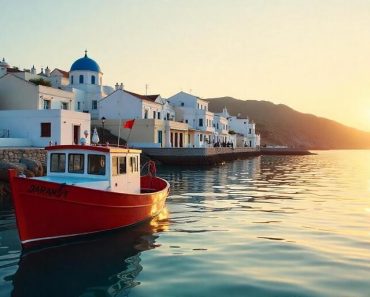Published on
August 12, 2025
By: Rana Pratap
The first half of 2025 has marked a record-breaking period for global tourism, with Qatar, Spain, the UAE, Saudi Arabia, Oman, Greece, Croatia, and Albania all seeing impressive growth in international arrivals. These nations have capitalized on strategic investments, effective media campaigns, and enhanced infrastructure to attract millions of visitors. From Qatar’s 3% growth in tourism to Spain’s 4.7% rise in visitors and Saudi Arabia’s massive 102% increase in international arrivals, these countries have emerged as major players in the tourism industry. This surge reflects a global shift toward more diverse and immersive travel experiences, driven by both cultural attractions and world-class events.
The success of these destinations can be attributed to their commitment to tourism development and sustainable growth. Countries like the UAE and Oman have focused on luxury and eco-tourism, while Greece and Croatia have embraced cultural tourism with increasing international interest. As the second half of 2025 unfolds, these countries are set to build on their momentum, with major events and continued investments expected to further drive growth and solidify their positions as global tourism leaders.
Qatar: A Rising Star in Global Tourism
Record-Breaking Visitor Arrivals: A 3% Surge in 2025
Qatar’s tourism sector continues to shine with remarkable growth in the first half of 2025. The country welcomed over 2.6 million international visitors between January and June, marking a 3% increase compared to the same period in 2024. The largest group of visitors originated from the GCC countries, making up 36% of the overall arrivals, followed by 26% from Europe and 22% from Asia and Oceania. The Americas and other Arab countries each accounted for 7% of visitors. Qatar’s strategic approach to tourism, focusing on easy accessibility, was evident in how visitors arrived—57% by air, 33% by land, and 9% by sea. This multi-access strategy highlights Qatar’s commitment to making the country a top global tourism destination.
Economic Impact: Tourism Fuels Qatar’s Growth
Tourism has become a major driver of Qatar’s economic success. In 2024, the sector contributed an impressive QAR55 billion to Qatar’s GDP, accounting for 8% of the country’s total economy. This represents a 14% increase compared to the previous year, signaling a growing economic impact. Qatar’s tourism sector is closely linked to its strategic plan, Tourism Strategy 2030, which aims to boost the industry’s share of GDP to 10-12%. With ongoing investments and a focus on infrastructure and global marketing, Qatar is steadily advancing toward these ambitious targets. The tourism sector not only brings in economic value but also supports job creation, local businesses, and international partnerships, further bolstering Qatar’s global standing.
World-Class Campaigns and Events Drive Growth
Qatar’s tourism growth in 2025 can be attributed to the success of its regional and international media campaigns, including the high-profile “Moments Made for You” initiative. This campaign focused on promoting Qatar’s summer experiences and was aimed at both GCC and international visitors. One of the key highlights was the promotional film featuring English football legend David Beckham, which showcased Qatar’s rich heritage, culture, modern attractions, and natural beauty. Alongside media campaigns, Qatar also hosted major events such as the Qatar Toy Festival, which drew over 130,000 visitors, and the Qatar International Food Festival, both of which contributed significantly to the growth in visitor numbers. These events have not only attracted tourists but have also enhanced Qatar’s reputation as a hub for world-class events, further strengthening its position in the global tourism market.
Looking Ahead: Major Events to Boost 2025 Even Further
The second half of 2025 holds even greater promise for Qatar’s tourism sector. The 2025/2026 cruise season is set to open in November, following last season’s successful 87 cruise ship calls, a 19% increase compared to the previous season, bringing in over 360,000 visitors. The country is set to host major global attractions in 2025, such as the FIFA Arab Cup Qatar 2025™, the F1® Qatar Airways Qatar Grand Prix 2025, and the anticipated release of the Michelin Guide Doha 2026. These high-profile events will attract thousands of international visitors, generating further tourism interest and solidifying Qatar’s status as a must-visit destination. With such a robust calendar of events and ongoing investments in infrastructure, Qatar’s tourism sector is positioned for even greater growth in the months ahead, offering residents and visitors world-class experiences year-round.
Qatar: A Fusion of Tradition and Modern Luxury
- Best Known For: Modern architecture, shopping malls, desert adventures.
- Must-See:
- Museum of Islamic Art: A stunning collection of Islamic artifacts.
- Souq Waqif: A traditional market offering spices, textiles, and souvenirs.
- The Pearl-Qatar: A luxury man-made island with shops, restaurants, and marinas.
- Other Places to Visit:
- Aspire Park: A large, peaceful park with a lake and walking paths.
- Qatar National Museum: Designed by Jean Nouvel, it tells the history of Qatar.
- Al Zubara Fort: A UNESCO World Heritage Site known for its role in the region’s history.
- Things to Do:
- Go on a desert safari and ride camels.
- Explore the waterfront along Doha’s Corniche.
- Visit the Katara Cultural Village for music, theater, and art.
- Tip: Dress modestly, especially in more traditional areas.
Spain: A Global Leader in Tourism Growth in 2025
Visitor Arrivals and Access: A 4.7% Rise in International Tourists
Spain continues to solidify its position as a global tourism leader, with over 44.5 million international tourists visiting in the first half of 2025, marking a 4.7% increase compared to the same period in 2024. The country remains a key destination for travelers from the United Kingdom, Germany, and France, which are its top source markets. Spain’s tourism sector benefits from excellent air connectivity, a wide variety of attractions, and year-round tourism opportunities. The increased arrivals are reflective of Spain’s strong appeal, driven by its vibrant cities, Mediterranean coastline, historical landmarks, and cultural festivals, which continue to attract millions of visitors from around the world.
Economic Impact: Tourism Drives Spain’s Economic Boom
Tourism plays a crucial role in Spain’s economy, contributing €59.62 billion in spending in the first half of 2025, a 7.5% rise from the previous year. This surge in spending indicates a qualitative boom in tourism, where not only are more visitors coming, but they are also spending more during their trips. The increase in daily expenditure per tourist reflects Spain’s success in attracting higher-value tourism. This growth has positively impacted the local economy, creating jobs, boosting the hospitality industry, and supporting small businesses across the country. Spain’s tourism sector is forecasted to continue its upward trajectory, contributing to its GDP and economic stability.
Media Campaigns and Major Events Fuel Spain’s Appeal
Spain’s tourism sector is thriving due to successful media campaigns and high-profile events. One such initiative is the “Spain is Great” campaign, which targets international travelers, showcasing Spain’s rich cultural heritage, diverse landscapes, and modern attractions. Alongside media campaigns, Spain’s iconic events, including the Running of the Bulls in Pamplona, La Tomatina in Buñol, and World Tourism Day festivities, continue to captivate international audiences. These events not only boost visitor numbers but also position Spain as a hub for unique cultural experiences that appeal to tourists seeking both adventure and tradition. Spain’s focus on promoting its diverse regions has also helped attract tourists to less-visited areas, further distributing tourism’s economic benefits across the country.
Looking Ahead: Spain’s Tourism Sector Set for More Growth in 2025
The second half of 2025 promises continued growth for Spain, with expectations of a strong summer season and a booming fall. The country anticipates welcoming millions of visitors in the coming months, driven by major international events like the 2025 FIBA World Cup, high-profile fashion shows, and cultural festivals. Spain’s tourism authorities are also focusing on enhancing the visitor experience by investing in sustainable tourism practices, improving infrastructure, and creating new attractions to keep the country appealing to both repeat and first-time visitors. With its combination of historical charm, modern amenities, and diverse cultural offerings, Spain is set to continue its rise as one of the world’s most popular and economically significant tourism destinations.
Spain: Where Passion Meets History and Beaches
- Best Known For: Rich history, art, vibrant nightlife, beaches.
- Must-See:
- Sagrada Familia (Barcelona): An iconic basilica by Antoni Gaudí.
- The Royal Palace (Madrid): The official residence of the Spanish royal family.
- Prado Museum: One of the finest art museums in the world, located in Madrid.
- Other Places to Visit:
- Park Guell (Barcelona): A public park with colorful mosaics and sculptures by Gaudí.
- Alhambra (Granada): A stunning fortress and palace with beautiful gardens.
- La Rambla (Barcelona): A bustling street filled with cafes, shops, and performers.
- Things to Do:
- Try tapas at local restaurants.
- Visit the beaches of Barcelona.
- Enjoy a Flamenco performance in Seville.
- Tip: Embrace the local siesta (afternoon break), especially in smaller towns.
UAE: Dubai Leads the Charge in Tourism Growth in 2025
Visitor Arrivals and Access: A Remarkable 6% Increase in Visitors
Dubai, a central tourism destination in the UAE, attracted 9.88 million international visitors in the first half of 2025, reflecting a 6% rise over the same period in 2024. The city’s strong performance is attributed to its robust air connectivity, exceptional hospitality, and a diverse range of attractions that cater to tourists of all tastes. Visitors flocked to Dubai not only for its luxury shopping, iconic landmarks, and thriving business environment but also for its burgeoning cultural scene and world-class events. The UAE’s seamless air, sea, and land access further contributes to the influx of international travelers, with Dubai being one of the most connected cities globally.
Tourism’s Role in Fueling UAE’s Economic Growth
Tourism remains a cornerstone of the UAE’s economic development. In 2025, the nation is poised to break a new record, surpassing AED 228.5 billion in tourism revenue, marking a 37% increase over the previous high set in 2019. Dubai, in particular, is seeing a significant boost to its economy through tourism, driven by high-value visitors who come for both business and leisure. The continued rise in spending per visitor shows the effectiveness of Dubai’s efforts to attract affluent travelers. The UAE’s tourism strategy, which focuses on luxury, innovation, and a strong events calendar, has proven successful in driving economic growth while also creating jobs in the hospitality, retail, and entertainment sectors.
Media Campaigns and Major Events: Showcasing UAE’s Global Appeal
Dubai’s tourism growth is largely driven by successful international media campaigns that highlight the city’s cultural diversity, cutting-edge developments, and luxury experiences. One of the key campaigns, “Live Your Dubai,” emphasizes the city’s wide-ranging attractions, from its ultra-modern skyscrapers to its rich cultural heritage. Major events such as the Dubai Expo 2025, Dubai Shopping Festival, and the Dubai World Cup continue to attract global attention, bringing in millions of visitors each year. These events not only showcase Dubai’s status as a world-class destination but also position the UAE as a key player in the international tourism market.
Looking Ahead: UAE’s Ongoing Tourism Innovation
The second half of 2025 is set to further solidify the UAE’s position as a leading global destination. With the upcoming launch of the Etihad Rail system in 2026, the country is investing in better connectivity between cities, enhancing access to tourism hotspots across the nation. The UAE government continues to prioritize sustainable tourism, focusing on projects that balance growth with environmental responsibility. As Dubai prepares for the upcoming 2025/2026 cruise season and other major events, such as international fashion weeks and global business summits, the tourism sector is expected to see sustained growth. The UAE’s vision to become a top global tourism destination is on track, offering visitors a blend of luxury, innovation, and cultural richness.
UAE: Glitz, Glamour, and Desert Dreams
- Best Known For: Futuristic skyline, luxury shopping, and desert experiences.
- Must-See:
- Burj Khalifa (Dubai): The world’s tallest building, offering stunning views.
- Sheikh Zayed Grand Mosque (Abu Dhabi): A breathtaking mosque with intricate designs.
- Dubai Mall: A giant shopping mall with attractions like an aquarium and an ice rink.
- Other Places to Visit:
- Palm Jumeirah: A man-made island with luxury resorts and restaurants.
- Dubai Marina: A vibrant area with restaurants, shops, and cruises.
- Louvre Abu Dhabi: A museum blending art and architecture.
- Things to Do:
- Go dune bashing and ride camels in the desert.
- Take a boat cruise through Dubai Marina.
- Explore the traditional souks (markets) for gold, spices, and perfumes.
- Tip: Public displays of affection are frowned upon, dress conservatively in public.
Saudi Arabia: Leading the Global Tourism Surge in 2025
Visitor Arrivals and Access: A 102% Increase in International Tourist Arrivals
Saudi Arabia has emerged as a global tourism powerhouse, leading the world in tourism growth. In the first quarter of 2025, the kingdom recorded a 102% increase in international tourist arrivals compared to the same period in 2019, surpassing both regional and global averages. This surge is largely due to the country’s Vision 2030 initiative, which aims to diversify the economy by focusing on tourism as a key sector. The expansion of modern infrastructure, visa reforms, and increased global marketing efforts have made Saudi Arabia an attractive destination for both leisure and business travelers. The kingdom’s rich cultural heritage, modern attractions, and religious significance continue to drive global interest.
Economic Influence: Tourism as a Central Element of Saudi Arabia’s Vision 2030
Tourism is rapidly becoming a critical sector for Saudi Arabia’s economic transformation. As part of its Vision 2030 strategy, the kingdom is aiming to position tourism as a cornerstone of its economic future. The sector is expected to contribute significantly to GDP, diversifying the economy away from oil dependency. The success of tourism in Saudi Arabia has led to new investments in infrastructure, including airports, hotels, and cultural sites, and has generated thousands of jobs. In addition, the sector’s rapid growth is encouraging further international investment, establishing Saudi Arabia as a rising global tourism destination.
Media Campaigns and Major Events: Showcasing Saudi Arabia’s Global Appeal
Saudi Arabia has made significant strides in marketing itself as a global tourism destination through high-profile campaigns such as “Experience Saudi Arabia,” aimed at attracting both leisure and business visitors. The kingdom’s rich cultural offerings, including historical sites like Al-Ula and the annual Hajj pilgrimage, have been central to these campaigns. Major international events, including the Riyadh International Film Festival and the Diriyah Formula E race, are bringing global attention to the country’s evolving tourism scene. Saudi Arabia’s efforts to host more international events have helped position it as a key player in the global tourism industry.
Looking Ahead: Saudi Arabia’s Ambitious Tourism Expansion in 2025 and Beyond
Looking ahead, Saudi Arabia is set to continue its meteoric rise in global tourism. The kingdom is focused on expanding its tourism offerings with the development of mega-projects such as the Red Sea Project, NEOM, and Qiddiya, which aim to blend modern luxury with rich cultural experiences. These projects are designed to attract a wide range of tourists, from adventure seekers to luxury travelers. In addition, Saudi Arabia is ramping up its efforts to develop religious tourism, particularly around Mecca and Medina, while also focusing on eco-tourism and sustainable travel initiatives. With Vision 2030 continuing to shape the tourism sector, Saudi Arabia’s tourism growth is expected to maintain its momentum, cementing the kingdom as one of the world’s fastest-growing destinations.
Saudi Arabia: A Journey Through History and Modern Wonders
- Best Known For: Islamic history, modern development, and rich cultural heritage.
- Must-See:
- Al-Masmak Fortress (Riyadh): A historic fort and symbol of Saudi heritage.
- King Fahd Fountain (Jeddah): The tallest water fountain in the world.
- The Red Sea Coast: Perfect for diving and water sports.
- Other Places to Visit:
- Diriyah: A UNESCO World Heritage site and the birthplace of the Kingdom of Saudi Arabia.
- Jeddah Corniche: A scenic coastline with parks and art installations.
- National Museum of Saudi Arabia: Offers insight into Saudi culture and history.
- Things to Do:
- Visit the Edge of the World for stunning views.
- Explore Riyadh’s shopping districts.
- Dive in the Red Sea and visit coral reefs.
- Tip: Women should check local dress codes and travel regulations (e.g., some restrictions on solo travel for women).
Oman: A Hidden Gem in Tourism Growth for 2025
Visitor Arrivals and Access: Strong Growth in International Visitors
Oman’s tourism sector is experiencing impressive growth, with the country welcoming a significant rise in international visitors in the first half of 2025. The luxury hotel sector alone saw an 18% increase in revenue, signaling Oman’s growing appeal as a premier destination for high-end travelers. Visitors are drawn to Oman’s unique blend of natural landscapes, including mountains, deserts, and pristine beaches, as well as its rich cultural heritage. The country’s strategic investments in air and sea connectivity have made it easier for tourists to explore, with improved access from key international markets, boosting Oman’s profile as a key player in the Gulf region’s tourism landscape.
Economic Impact: Tourism’s Rising Role in Oman’s Economy
Tourism is becoming an increasingly important sector for Oman’s economic diversification. In the first half of 2025, the country reported a 9.2% increase in the number of guests staying in its premium hotels, underscoring the sector’s significant contribution to economic growth. Oman’s government has been actively promoting tourism as a way to reduce the economy’s dependence on oil. The 18.2% rise in revenues from three- to five-star hotels is just one example of how tourism is playing a pivotal role in supporting Oman’s economic expansion, job creation, and infrastructure development. The ongoing tourism boom is aligned with Oman’s long-term strategy to enhance its appeal as a destination for cultural and nature-based tourism.
Media Campaigns and Major Events: Showcasing Oman’s Unique Attractions
Oman has stepped up its global marketing efforts, positioning itself as a destination for authentic, off-the-beaten-path experiences. Through initiatives such as the “Oman – Naturally” campaign, the country is highlighting its natural beauty, including its iconic mountains, wildlife, and coastline. The government has also focused on showcasing its cultural treasures, from ancient forts to traditional souks, which attract cultural and heritage tourism. Major events like the Muscat Festival and the Salalah Tourism Festival have become key drivers of tourism, drawing visitors from across the globe. These events celebrate Oman’s culture, arts, and traditions, making the country a growing destination for travelers seeking unique and immersive experiences.
Future Outlook: Promising Growth for Oman’s Tourism in 2025
The second half of 2025 promises to be even more exciting for Oman’s tourism sector, with several new initiatives and developments on the horizon. The country is investing heavily in sustainable tourism, focusing on eco-friendly projects that preserve its natural landscapes while attracting more visitors. New luxury resorts, eco-tourism developments, and adventure tourism experiences are being introduced to meet the growing demand for high-quality travel experiences. Oman’s picturesque mountain region, Jabal Akhdar, is set to see even more visitors, with a 5.8% increase in tourism to the area in the first half of 2025 alone. As Oman continues to focus on its unique cultural heritage, natural beauty, and sustainable growth, the country’s tourism sector is set for even greater expansion in the coming years.
Oman: A Land of Majestic Mountains and Serene Beaches
- Best Known For: Natural beauty, mountains, and unique cultural blend.
- Must-See:
- Sultan Qaboos Grand Mosque: A magnificent mosque with beautiful interiors.
- Muttrah Souq: A traditional market for spices, jewelry, and antiques.
- Al Jalali and Al Mirani forts: Two forts guarding Muscat’s harbor.
- Other Places to Visit:
- Wadi Shab: A stunning natural gorge with pools and waterfalls.
- Nizwa Fort: A 17th-century fort known for its ancient architecture.
- Bahla Fort: Another UNESCO World Heritage site, famous for its historic significance.
- Things to Do:
- Take a dhow cruise in the Arabian Sea.
- Explore the desert and go camping under the stars.
- Go hiking in the Hajar Mountains.
- Tip: Respect the local traditions and avoid loud behavior, especially in rural areas.
Greece: A Tourism Powerhouse Surging in 2025
Visitor Arrivals and Access: A 5.7% Growth in International Tourists
Greece continues to see remarkable growth in tourism, with a 5.7% increase in international air arrivals in the first half of 2025, reaching a total of 10.3 million visitors. This strong growth reflects the country’s enduring appeal, driven by its rich history, stunning islands, and vibrant cities. The increase in arrivals has been particularly noticeable from non-EU countries, with a 15.1% rise in revenue from international visitors, including a 15.9% increase in receipts from U.S. tourists. Greece’s well-connected airports, as well as its luxurious resorts and rich cultural offerings, have made it a key destination in Europe, attracting a wide range of travelers.
Economic Impact: Tourism’s Major Contribution to Greece’s Economy
Tourism remains a critical driver of Greece’s economy, contributing significantly to the nation’s GDP. In 2025, Greece saw a 12.7% increase in travel receipts, totaling €4.35 billion in the first five months, highlighting the crucial role of tourism in the country’s economic growth. The country is seeing a shift towards higher-value tourism, with visitors spending more on experiences, luxury accommodations, and local products. This rise in revenue is helping to support the Greek economy, create jobs in the hospitality and retail sectors, and contribute to the overall economic recovery post-pandemic. Greece’s government continues to focus on attracting high-spending visitors while maintaining the quality of its tourism offerings.
Media Campaigns and Major Events: Greece’s Year-Round Appeal
Greece’s tourism industry is thriving thanks to ongoing media campaigns that showcase its diverse attractions. The “All You Want Is Greece” campaign has been particularly successful in highlighting the country’s unique blend of ancient history, stunning natural beauty, and modern hospitality. Greece also continues to host world-renowned cultural events, including the Athens and Epidaurus Festival, which celebrates Greece’s rich cultural heritage with performances, exhibitions, and artistic showcases. These high-profile events, coupled with the country’s strategic marketing efforts, have significantly increased its appeal to international travelers, making it one of the most sought-after destinations in Europe.
Looking Ahead: Greece Set for More Tourism Growth in 2025
Looking to the second half of 2025, Greece is preparing for even more success in its tourism sector. The country expects to see a 4.6% increase in visitors from the U.S., Turkey, and Israel during the off-peak months of August to October. Greece is also focusing on attracting tourists during the shoulder seasons, thanks to improved tourism infrastructure and enhanced visitor experiences. With its continued focus on sustainability, unique cultural offerings, and stunning landscapes, Greece is poised to remain a top global destination for travelers, promising to build on its tourism growth in the years ahead.
Greece: Sun, Sea, and Ancient Secrets
- Best Known For: Ancient ruins, stunning islands, Mediterranean cuisine.
- Must-See:
- Acropolis: Ancient citadel with the Parthenon.
- Sagrada Familia (Barcelona): The iconic basilica.
- Temple of Apollo: An ancient ruin with stunning views.
- Other Places to Visit:
- Santorini: Famous for its white-washed buildings and sunset views.
- Mykonos: A famous island for beaches and vibrant nightlife.
- Crete: The largest Greek island, known for its beaches and the Palace of Knossos.
- Things to Do:
- Take a boat tour around the islands.
- Try local dishes like moussaka, souvlaki, and tzatziki.
- Visit the ancient ruins of Delphi or Olympia.
- Tip: Be prepared for crowds in tourist hotspots during summer months.
Croatia: A Mediterranean Gem Leading Tourism Growth in 2025
Visitor Arrivals and Access: A 4% Increase in International Arrivals
In 2025, Croatia is experiencing robust tourism growth, recording 7.5 million arrivals and 29.3 million overnight stays in the first half of the year, marking a 4% rise compared to 2024. The growth rate accelerated in June, with a 9% rise in arrivals and a 12% increase in overnight stays compared to the same month last year. Croatia’s Mediterranean charm, with its stunning coastline, historical towns, and crystal-clear waters, continues to draw tourists from across Europe and beyond. The country’s excellent air connectivity, particularly to major European cities, makes it a convenient and popular summer destination.
Economic Impact: Tourism Fuels Croatia’s Economy
Tourism is a key driver of Croatia’s economy, and 2025 is proving to be a standout year. The country’s tourism sector is benefiting from strong demand during both the peak summer months and the shoulder seasons, which has led to higher spending per visitor. With its continued success in attracting European tourists, particularly from Germany, the UK, and Italy, Croatia is on track to set new records in tourism revenues in 2025. This growth not only supports the economy but also creates employment opportunities, boosts local businesses, and generates significant revenue from hospitality, retail, and transportation.
Media Campaigns and Major Events: Croatia’s Rise as a Premier Destination
Croatia’s tourism growth has been supported by strategic media campaigns that emphasize the country’s stunning natural beauty and rich cultural heritage. The “Croatia Full of Life” campaign continues to showcase the country as a destination offering everything from pristine beaches to vibrant cities, along with unique cultural and gastronomic experiences. Croatia is also gaining international recognition as a luxury tourism destination, with a growing number of high-end hotels, resorts, and yachts attracting affluent travelers. Major events such as the Dubrovnik Summer Festival and Ultra Europe Music Festival continue to draw significant crowds, boosting the country’s global profile as a year-round destination for cultural and leisure tourism.
Looking Ahead: Croatia Set for Record-Breaking Summer and Beyond
The second half of 2025 promises continued growth for Croatia’s tourism sector. With a projected increase in international visitors and a growing number of direct flights from key markets, the country is well-positioned for a strong peak season. Croatia is also enhancing its tourism offerings by investing in new luxury resorts, eco-tourism initiatives, and cultural experiences that cater to diverse traveler preferences. As the country continues to showcase its unique Mediterranean charm, it’s set to remain one of Europe’s most sought-after destinations for both leisure and cultural tourism.
Croatia: A Glimpse Into the Mediterranean’s Best-Kept Secret
- Best Known For: Historic architecture, beautiful coastlines, and Game of Thrones filming locations.
- Must-See:
- Old Town of Dubrovnik: A UNESCO World Heritage site with impressive city walls.
- Diocletian’s Palace (Split): A Roman emperor’s palace now turned into a lively part of the city.
- Plitvice Lakes National Park: Known for its stunning lakes and waterfalls.
- Other Places to Visit:
- Hvar: A beautiful island known for its beaches and nightlife.
- Zadar: Famous for the Sea Organ and Sun Salutation installations.
- Rovinj: A charming town on the Istrian Peninsula.
- Things to Do:
- Walk along the city walls of Dubrovnik.
- Explore the ancient Roman ruins in Split.
- Take a boat tour to the nearby islands.
- Tip: Plan your visit to avoid the peak tourist season (July-August).
Albania: A Rising Star in European Tourism in 2025
Visitor Arrivals and Access: A 5% Increase in Foreign Visitors
Albania’s tourism sector is flourishing, with a 5% increase in international arrivals in the first half of 2025, reaching a total of 4.76 million visitors. This growth reflects the country’s increasing appeal as a unique destination in the Balkans, known for its unspoiled landscapes, rich history, and vibrant culture. Albania’s coastal regions, including the Albanian Riviera, are particularly popular, attracting travelers seeking both relaxation and adventure. The country’s improving infrastructure and ease of access, with more international flights and growing cruise traffic, are making it an increasingly attractive option for travelers exploring new and less crowded destinations.
Economic Impact: Tourism Boosts Albania’s Economic Growth
Tourism is playing a pivotal role in Albania’s economic development. In 2025, the sector is expected to generate significant revenue, contributing to both the local economy and national GDP. As the number of international visitors continues to grow, the country is seeing increased spending in the hospitality, transportation, and service sectors. The Albanian government has recognized the value of tourism and is continuing to invest in its growth, particularly in enhancing infrastructure and promoting sustainable tourism practices. However, the country faces challenges in keeping pace with rapid growth, particularly in terms of service quality and infrastructure development, which will be crucial for sustaining long-term success.
Media Campaigns and Major Events: Albania’s Cultural Appeal Gains Global Attention
Albania is stepping up its marketing efforts to position itself as a prime cultural and eco-tourism destination. The government’s initiatives focus on promoting the country’s UNESCO World Heritage sites, natural beauty, and the authenticity of its local traditions. Albania is also becoming more visible in international tourism events, increasing its presence at global tourism fairs and collaborating with travel agencies to offer tailored packages. Additionally, Albania’s cultural events, such as the National Folklore Festival and the Tirana International Film Festival, attract global attention, helping to build its reputation as a destination for travelers seeking both cultural immersion and adventure.
Looking Ahead: Albania’s Tourism Growth Set to Continue
Albania’s tourism sector is expected to continue its positive momentum into the second half of 2025. With its rising international profile and increasing investments in tourism infrastructure, Albania is set to build on its momentum as a growing destination in Europe. The government’s focus on sustainable tourism and improved services will be essential to maintaining quality as visitor numbers rise. Additionally, the country is expected to continue benefiting from its proximity to other popular destinations in the Balkans, offering travelers a unique experience that blends historical richness with natural beauty. As Albania continues to develop its tourism sector, it is likely to see even greater success in the coming years, solidifying its place as one of Europe’s rising stars.
Albania: The Uncharted Gem of the Balkans
- Best Known For: Ancient ruins, stunning beaches, and mountainous landscapes.
- Must-See:
- Skanderbeg Square (Tirana): A central square dedicated to Albania’s national hero.
- Berat Castle: A UNESCO World Heritage site with ancient buildings and great views.
- Dajti Mountain: A scenic mountain accessible by cable car, offering panoramic views of Tirana.
- Other Places to Visit:
- Llogara Pass: A breathtaking mountain pass with incredible views.
- Butrint National Park: A UNESCO-listed archaeological site.
- Ksamil Beach: Known for its crystal-clear waters and beautiful sandy beaches.
- Things to Do:
- Explore the ancient ruins at Butrint.
- Take a scenic drive along the Albanian Riviera.
- Try Albanian cuisine, including specialties like tavë kosi and byrek.
- Tip: Albania is still an undiscovered gem compared to other European destinations, so enjoy its less crowded appeal.
In the first half of 2025, Qatar, Spain, UAE, Saudi Arabia, Oman, Greece, Croatia, and Albania all experienced record tourism growth, driven by strategic investments, world-class events, improved infrastructure, and effective media campaigns, solidifying their positions as global tourism leaders.
In conclusion, the first half of 2025 has proven to be a turning point for global tourism, with Qatar, Spain, UAE, Saudi Arabia, Oman, Greece, Croatia, and Albania leading the charge in record-breaking growth. The impressive rise in visitor numbers across these destinations highlights the effectiveness of well-executed strategies, such as enhanced infrastructure, targeted marketing, and the hosting of high-profile international events. As these countries continue to innovate and invest in their tourism sectors, the second half of 2025 is poised to bring even greater success, further cementing their status as key players in the global tourism landscape. The global tourism industry is witnessing a shift, with diverse and unique travel experiences now taking center stage, ensuring that these destinations remain in high demand for years to come.







